
Mintaka, designation Delta Orionis and 34 Orionis, is a multiple star system some 1,200 light-years from the Sun in the constellation of Orion. Together with Alnitak and Alnilam, the three stars form Orion's Belt, known by many names among ancient cultures. The star is located very close to the celestial equator. When Orion is near the meridian, Mintaka is the rightmost of the Belt's stars when viewed from the Northern Hemisphere facing south.
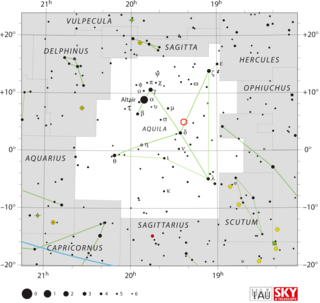
V1494 Aquilae or Nova Aquilae 1999 b was a nova which occurred during 1999 in the constellation Aquila and reached a brightness of magnitude 3.9 on 2 December 1999. making it easily visible to the naked eye. The nova was discovered with 14×100 binoculars by Alfredo Pereira of Cabo da Roca, Portugal at 18:50 UT on 1 December 1999, when it had a visual magnitude of 6.0.
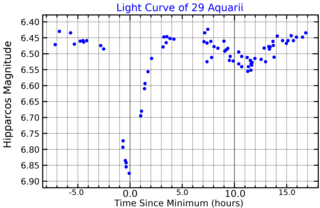
29 Aquarii is a binary star system located around 590 light years away from the Sun in the equatorial constellation of Aquarius. 29 Aquarii is the Flamsteed designation; the system also bears the variable star designation DX Aquarii. It is a challenge to view with the naked eye, appearing as a dim star with a combined apparent visual magnitude of 6.39. The system is moving further from the Earth with a heliocentric radial velocity of about +15 km/s.

Mu Cassiopeiae, Latinized from μ Cassiopeiae, is a binary star system in the constellation Cassiopeia. This system shares the name Marfak with Theta Cassiopeiae, and the name was from Al Marfik or Al Mirfaq (المرفق), meaning "the elbow". It is dimly visible to the naked eye as a point of light with an apparent visual magnitude of 5.16. The system is located at a distance of 25 light years from the Sun based on parallax, and is moving closer with a high radial velocity of −98 km/s. This star will move into the constellation Perseus around 5200 AD.
HD 115404 is a binary star system located in the constellation Coma Berenices. Parallax measurements made by Hipparcos put the system at 36 light-years, or 11 parsecs, away. The combined apparent magnitude of the system is 6.52, with the magnitudes of the components being 6.66 and 9.50.

HW Virginis, abbreviated HW Vir, is an eclipsing binary system, approximately 563 light-years away based on the parallax measured by the Gaia spacecraft, in the constellation of Virgo. The system comprises an eclipsing B-type subdwarf star and red dwarf star. The two stars orbit each other every 0.116795 days.

NN Serpentis is an eclipsing post-common envelope binary system approximately 1670 light-years away. The system comprises an eclipsing white dwarf and red dwarf. The two stars orbit each other every 0.13 days.

V1094 Scorpii is a young stellar object in the constellation of Scorpius, located in the young Lupus Star Forming Region. It is being orbited by a protoplanetary disk that extends out to a distance of 300 AU from the host star. There are gaps at 100 AU and 170 AU, with bright rings at 130 AU and 220 AU.

59 Cygni is a multiple star system in the northern constellation of Cygnus, located roughly 1,300 light years away from Earth. It is visible to the naked eye as a blue-white hued star with a combined apparent visual magnitude of 4.74.

Chi2 Hydrae, Latinised from χ2 Hydrae, is a binary star system in the equatorial constellation of Hydra. Based upon an annual parallax shift of 4.6 mas as seen from Earth, it is located roughly 685 light years from the Sun. It is visible to the naked eye with a combined apparent visual magnitude of about 5.7.

RR Caeli is an eclipsing binary star in the constellation Caelum. It is 69 light years from Earth.

HD 106906 is a binary star system in the southern constellation of Crux. It is too faint to be visible to the naked eye, having a combined apparent visual magnitude of 7.80. The distance to this system is approximately 337 light years based on parallax, and it is receding from the Sun with a radial velocity of +10 km/s. It is a member of the Lower Centaurus–Crux group of the Scorpius–Centaurus OB association of co-moving stars.

WR 21a is an eclipsing binary star in the constellation Carina. It includes one of the most massive known stars and is one of the most massive binaries.

GG Tauri, often abbreviated as GG Tau, is a quintuple star system in the constellation Taurus. At a distance of about 450 light years away, it is located within the Taurus-Auriga Star Forming Region. The system comprises three stars orbiting each other in a hierarchical triple system, known as GG Tauri A, and another binary star system more distant from the central system, known as GG Tauri B.

IRAS 08544−4431 is a binary system surrounded by a dusty ring in the constellation of Vela. The system contains an RV Tauri variable star and a more massive but much less luminous companion.
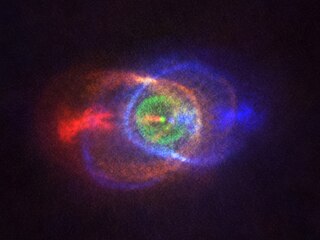
A post-common envelope binary (PCEB) or pre-cataclysmic variable is a binary system consisting of a white dwarf or hot subdwarf and a main-sequence star or a brown dwarf. The star or brown dwarf shared a common envelope with the white dwarf progenitor in the red giant phase. In this scenario the star or brown dwarf loses angular momentum as it orbits within the envelope, eventually leaving a main-sequence star and white dwarf in a short-period orbit. A PCEB will continue to lose angular momentum via magnetic braking and gravitational waves and will eventually begin mass-transfer, resulting in a cataclysmic variable. While there are thousands of PCEBs known, there are only a few eclipsing PCEBs, also called ePCEBs. Even more rare are PCEBs with a brown dwarf as the secondary. A brown dwarf with a mass lower than 20 MJ might evaporate during the common envelope phase and therefore the secondary is supposed to have a mass higher than 20 MJ.

2MASS J15104761–2818234, sometimes shortened to 2M1510, is a triple or possibly quadruple brown dwarf system, consisting of the eclipsing binary 2M1510A and the wide companion 2M1510B. 2M1510A was found to be an eclipsing binary in the first light data of the SPECULOOS telescopes. It is only the second eclipsing binary brown dwarf found so far, the other is 2M0535-05. The system verified theoretical models for how brown dwarfs cool. The system is located 120 light-years away from earth in the constellation Libra.
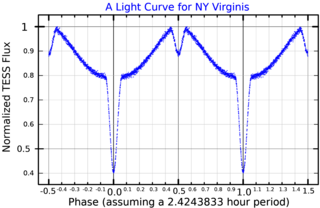
NY Virginis is a binary star about 1,940 light-years away. The primary belongs to the rare class of subdwarf B stars, being former red giants with their hydrogen envelope completely stripped by a stellar companion. The companion is a red dwarf star. The binary nature of NY Virginis was first identified in 1998, and the extremely short orbital period of 0.101016 d, together with brightness variability on the timescale of 200 seconds was noticed, resulting in the identification of the primary star as a B-type subdwarf in 2003. Under a proposed classification scheme for hot subdwarfs it would be class sdB1VII:He1. This non-standard system indicates that it is a "normal" luminosity for a hot subdwarf and that the spectrum is dominated by hydrogen rather than helium.

HS Hydrae is a triple star system in the equatorial constellation of Hydra. The inner pair were an eclipsing binary during the period 1920 until 2019, with HS Hya being the variable star designation. With a base apparent visual magnitude of 8.08, HS Hya is too dim to be viewed with the naked eye. During the primary eclipse, the magnitude dropped to 8.61; the secondary eclipse lowered the magnitude to 8.55. Based on parallax measurements, the system is located at a distance of approximately 335 light years from the Sun. It is drifting closer with a mean radial velocity of −7 km/s.
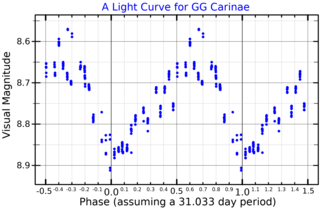
GG Carinae is a binary star system in the southern constellation of Carina, abbreviated GG Car. It is a variable star with a brightness that fluctuates around an apparent visual magnitude of 8.67, making it too faint to be visible to the naked eye. The distance to this system is approximately 8,000 light years based on parallax measurements.



















